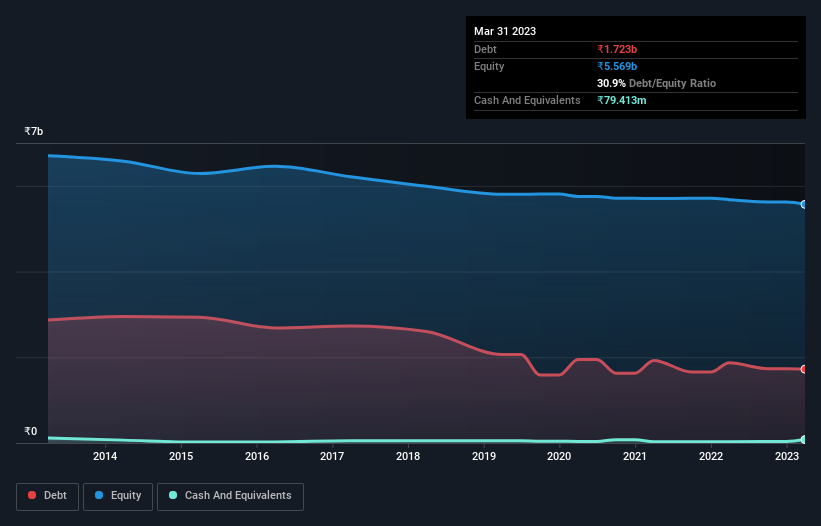- India
- /
- Real Estate
- /
- NSEI:PRAENG
Does Prajay Engineers Syndicate (NSE:PRAENG) Have A Healthy Balance Sheet?
Warren Buffett famously said, 'Volatility is far from synonymous with risk.' It's only natural to consider a company's balance sheet when you examine how risky it is, since debt is often involved when a business collapses. We note that Prajay Engineers Syndicate Limited (NSE:PRAENG) does have debt on its balance sheet. But the more important question is: how much risk is that debt creating?
When Is Debt Dangerous?
Debt assists a business until the business has trouble paying it off, either with new capital or with free cash flow. Part and parcel of capitalism is the process of 'creative destruction' where failed businesses are mercilessly liquidated by their bankers. However, a more usual (but still expensive) situation is where a company must dilute shareholders at a cheap share price simply to get debt under control. Of course, debt can be an important tool in businesses, particularly capital heavy businesses. The first thing to do when considering how much debt a business uses is to look at its cash and debt together.
Check out our latest analysis for Prajay Engineers Syndicate
What Is Prajay Engineers Syndicate's Net Debt?
As you can see below, Prajay Engineers Syndicate had ₹1.72b of debt at March 2023, down from ₹1.87b a year prior. However, it does have ₹79.4m in cash offsetting this, leading to net debt of about ₹1.64b.

How Healthy Is Prajay Engineers Syndicate's Balance Sheet?
We can see from the most recent balance sheet that Prajay Engineers Syndicate had liabilities of ₹2.16b falling due within a year, and liabilities of ₹1.69b due beyond that. Offsetting these obligations, it had cash of ₹79.4m as well as receivables valued at ₹1.39b due within 12 months. So its liabilities total ₹2.39b more than the combination of its cash and short-term receivables.
The deficiency here weighs heavily on the ₹971.4m company itself, as if a child were struggling under the weight of an enormous back-pack full of books, his sports gear, and a trumpet. So we definitely think shareholders need to watch this one closely. At the end of the day, Prajay Engineers Syndicate would probably need a major re-capitalization if its creditors were to demand repayment. When analysing debt levels, the balance sheet is the obvious place to start. But it is Prajay Engineers Syndicate's earnings that will influence how the balance sheet holds up in the future. So if you're keen to discover more about its earnings, it might be worth checking out this graph of its long term earnings trend.
Over 12 months, Prajay Engineers Syndicate made a loss at the EBIT level, and saw its revenue drop to ₹487m, which is a fall of 48%. To be frank that doesn't bode well.
Caveat Emptor
While Prajay Engineers Syndicate's falling revenue is about as heartwarming as a wet blanket, arguably its earnings before interest and tax (EBIT) loss is even less appealing. To be specific the EBIT loss came in at ₹47m. Considering that alongside the liabilities mentioned above make us nervous about the company. It would need to improve its operations quickly for us to be interested in it. For example, we would not want to see a repeat of last year's loss of ₹91m. And until that time we think this is a risky stock. The balance sheet is clearly the area to focus on when you are analysing debt. But ultimately, every company can contain risks that exist outside of the balance sheet. For example - Prajay Engineers Syndicate has 1 warning sign we think you should be aware of.
If, after all that, you're more interested in a fast growing company with a rock-solid balance sheet, then check out our list of net cash growth stocks without delay.
New: Manage All Your Stock Portfolios in One Place
We've created the ultimate portfolio companion for stock investors, and it's free.
• Connect an unlimited number of Portfolios and see your total in one currency
• Be alerted to new Warning Signs or Risks via email or mobile
• Track the Fair Value of your stocks
Have feedback on this article? Concerned about the content? Get in touch with us directly. Alternatively, email editorial-team (at) simplywallst.com.
This article by Simply Wall St is general in nature. We provide commentary based on historical data and analyst forecasts only using an unbiased methodology and our articles are not intended to be financial advice. It does not constitute a recommendation to buy or sell any stock, and does not take account of your objectives, or your financial situation. We aim to bring you long-term focused analysis driven by fundamental data. Note that our analysis may not factor in the latest price-sensitive company announcements or qualitative material. Simply Wall St has no position in any stocks mentioned.
About NSEI:PRAENG
Prajay Engineers Syndicate
Engages in the construction, development, maintenance, and sale of residential, commercial, hospitality, and retail properties in India.
Excellent balance sheet and good value.
Market Insights
Community Narratives




